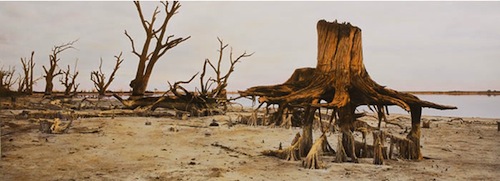Nici Cumpston, Ringbarked 2008, archival print on canvas, hand-coloured with pencil and watercolour.
Source: Unisa
I think one of the main highlights of her presentation apart from the array of works she collected from the Desert regions, were definitely her own photography of one of the largest fresh water lakes in Australia. I think they were amazing - her photographs seems to have this unique quality to them, especially through the technique she uses of hand colouring the black and white photographs using water colour, pencils or acrylic. They emmenate a sense of serenity; it looked realistic and surrealistic at the same time, almost dream-like. However, what is most significant of her photographs is the story behind them - a story about looking at sites from an Aboriginal perspective and about showing the presence of Aboriginal people from long ago.
Nici Cumpston, Keeper 2008, inkjet print on Hahnemuhle paper
Source: FLASH
After looking at her photographs, you can really see that these "hidden meanings" comes back to the difference in perspective of how Aboriginal and non-Aboriginal people see the land. In the lecture, Nici mentioned the use of the word "remote" used by many to describe places outside the city which we think are void and scarce when to Aboriginal people it is actually a place full of sites - it is the center of the earth for them. Just like during the colonization period, the settlers simply conquered the land by their own will, which in part is I think because of their perception that the land was not being used:
What we may see as normal landscape photography, they are not. Nici's photographs are of sites that have significance for the Aboriginal people:
This is the fundamental issue beneath the disputes about land between Aboriginal and non-Aboriginal people. In the video "Old Country, New Country,"an Aboriginal man shows his deep concern and frustration on how non-Aboriginal people have built factories in his homeland. It is their responsibility to take care of the land (3) but they can't, they do not have the power to do so. The land is more to Aboriginal people than what many of us may see it as - The Mountain Gulaga to the Umbarra people is a "Dreaming woman; the mountain is her body"(4) and it is sacred and important to them:
I think this truly highlights the importance in acknowledging that while places mean different things to people, we need to respect each other. Even though it may seem like a small thing how Nici used the original Aboriginal names of the places she collected artworks for her exhibiton before the English names, it shows a sense of recognition that this land belongs to the Aboriginal people, in the same way the reconciliation sculptures around the city have been created and Aboriginal names have been used to name parklands and several buildings.
References:
(1) Sylvia Kleinert and Margo Neale, ed., The Oxford Companion to Aboriginal Art and Culture (Melbourne: Oxford University Press, 2000), 40.
(2) Ibid.
(3) Ibid., 45.
(4) Ibid.
(5) Ibid., 46.
(6) Ibid.
The conquest of the 'new world' was accomplished by people who were convinced that they had both the ability and the right to go anywhere and to claim anything. In their arrogance and violence they walked into and on top of the sacred palces of the world they claimed, without even knowing where they were. (1)
What we may see as normal landscape photography, they are not. Nici's photographs are of sites that have significance for the Aboriginal people:
A site is place. The power that created the world is located here, and when a persona walks to this place, they put their body in the locus of creation. The beings who amde and make the world have left something here- their body, thier power, their conciousness, their Law. To stand here is to be known by that power. (2)
This is the fundamental issue beneath the disputes about land between Aboriginal and non-Aboriginal people. In the video "Old Country, New Country,"an Aboriginal man shows his deep concern and frustration on how non-Aboriginal people have built factories in his homeland. It is their responsibility to take care of the land (3) but they can't, they do not have the power to do so. The land is more to Aboriginal people than what many of us may see it as - The Mountain Gulaga to the Umbarra people is a "Dreaming woman; the mountain is her body"(4) and it is sacred and important to them:
They should not log the mountain. If they keep on logging there'll be nothing there. We'll have nothing to show our kids. It will be just a legend. (5)
I think this truly highlights the importance in acknowledging that while places mean different things to people, we need to respect each other. Even though it may seem like a small thing how Nici used the original Aboriginal names of the places she collected artworks for her exhibiton before the English names, it shows a sense of recognition that this land belongs to the Aboriginal people, in the same way the reconciliation sculptures around the city have been created and Aboriginal names have been used to name parklands and several buildings.
"You've got to understand- I'd give my life for this mountain"(6)
(1) Sylvia Kleinert and Margo Neale, ed., The Oxford Companion to Aboriginal Art and Culture (Melbourne: Oxford University Press, 2000), 40.
(2) Ibid.
(3) Ibid., 45.
(4) Ibid.
(5) Ibid., 46.
(6) Ibid.



No comments:
Post a Comment